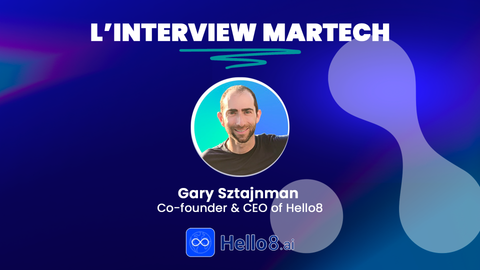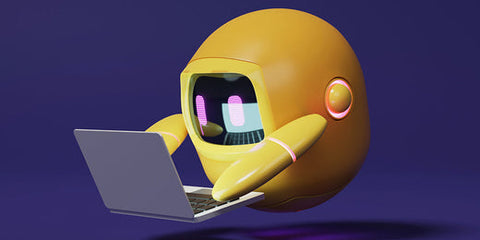This month in the Martech Interview: A conversation with Gary Sztajnman, co-founder of Hello8, a video translation solution for corporate training.
How did the idea for Hello8 come about?
At Hello8, we specialize in video translation. I’ve spent many years living abroad, so speaking different languages and accessing content in multiple languages has always been a personal challenge for me. I’ve also worked for a long time on AI technologies related to voice, facial expressions, and physical appearance. About 3–4 years ago, our team had the idea to experiment with voice translation and lip synchronization.
The problem back then was that the technology just wasn’t mature enough. For example, it used to take 30 minutes of voice recording to train an AI to speak like you in another language. Today, it only takes a few seconds for an AI to replicate your voice. As a result, it’s now possible to translate videos very easily while maintaining high quality. That’s why this idea of AI-powered video translation evolved from just a concept to a real business.
What is Hello8’s positioning?
We spent a lot of time defining our positioning because there are already many video translation applications out there. Naturally, people think of translating movies for Netflix or TV series. But that’s not really the direction we wanted to take. Initially, we explored a mobile app concept, thinking people could translate videos they shared with each other. We interviewed many industries and spoke with a lot of stakeholders across media, e-commerce, and more.
In the end, what made the most sense for us was the corporate training market. Large companies have thousands of employees across different countries who speak different languages and need access to training content in their own language. There’s a real need for these companies to create content and then translate it into multiple languages to make it accessible to all employees. For us, this is the segment with the strongest potential—where we see genuine demand and highly satisfied users.
Who are your users?
We’re targeting the corporate training sector, with three main user groups: IT departments in large companies who manage all things tech and AI; Learning & Development (L&D) teams, who are less technical but responsible for translating training content; video production agencies specializing in training content, who sell both the original and translated versions to their clients.
What’s your favorite feature in Hello8?
As I started using our product extensively, I realized something: Hello8 automatically translates everything that’s said in a video, but sometimes you’re not happy with a translation. So we developed a seemingly simple feature called “RETRANSLATE” that lets you generate an alternative translation.
But what people may not realize is that translating video isn’t just about words—it’s crucial for the timing to align, so the translated voice matches the original speaking moments and makes the dubbing feel natural. So when you retranslate a sentence, it’s not just generating a new translation. Behind the scenes, we test multiple translations, multiple phrasings, and find the one with the best tempo and rhythm to ensure it fits perfectly within the video. In the end, this makes the tool much more precise and allows users to achieve the best possible translation.
Are you integrating with other tools?
We’re working on several types of integrations. Often, it’s not just one person handling translation inside a company—it could be an interpreter, a subject-matter expert, a manager, or someone from IT. To support collaboration, integrations are key. For example, we’re working on integrating with Slack, so a translated video automatically notifies a channel. We’re also building integrations with tools like Articulate 360, a leading platform in the training industry. These are the kinds of features we’re actively developing.
How do you handle customer support if users encounter technical issues?
We’re very close to our customers and their projects—we really want to guide them toward success. That’s why we’re not afraid to communicate directly via email, one-on-one, as well as through the platform’s help module. You’re not chatting with a bot; we’re actually there behind the scenes, answering queries sometimes within a minute or even seconds. And if it’s overnight, then first thing the next morning. We’re genuinely hands-on with our users.
What are your goals for 2025?
Naturally, growth: we want to acquire many more clients and expand our team. We’re a young platform, but we’re very proud of what we’ve achieved so far and the positive feedback from our customers. In terms of product, we aim to support even more types of training-related files so we can truly become the best-in-class solution for training content translation.
Ultimately, we want to be the go-to solution—when people think of video translation for corporate training, we want them to think of Hello8. We’ve also got a rich feature roadmap around subtitles and highly precise retranslation capabilities… there’s a lot we’re excited to deliver for our users.
How do you plan to stay ahead of OpenAI, Google, or Meta?
If you look at the latest data keynotes from Meta, OpenAI, or Google, everyone’s working on translation. People want to translate YouTube videos automatically. There’s so much happening in this space. We’re not trying to compete head-on with Meta, Google, or Microsoft—it wouldn’t make sense. Our goal is to find a specific niche where we can be the best, and to create a user experience that’s highly specialized for our domain and customers. We’re lucky to be very close to our users; we know exactly what they want—and OpenAI won’t be building such a specialized tool for them.
OpenAI, Mistral, Gemini, or Claude?
For me, OpenAI still offers the best user experience, the best results, and consistently leads in new features.
Thank you, Gary!
Interested in another interview? Check out our conversation with Lionel Fumado on data hybridization at Orange.





